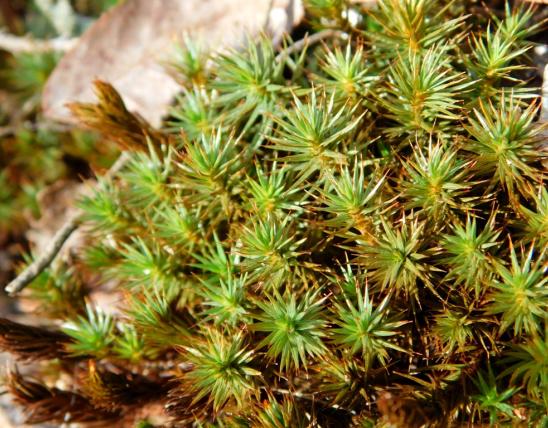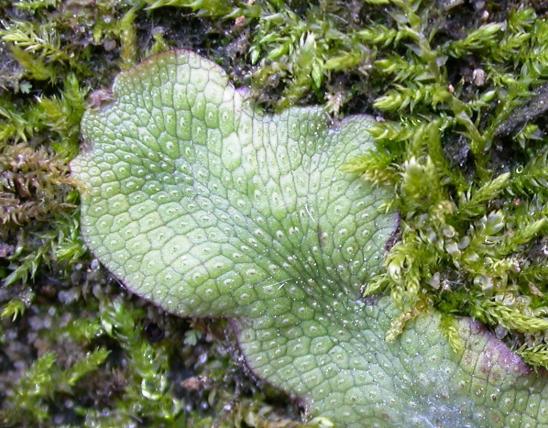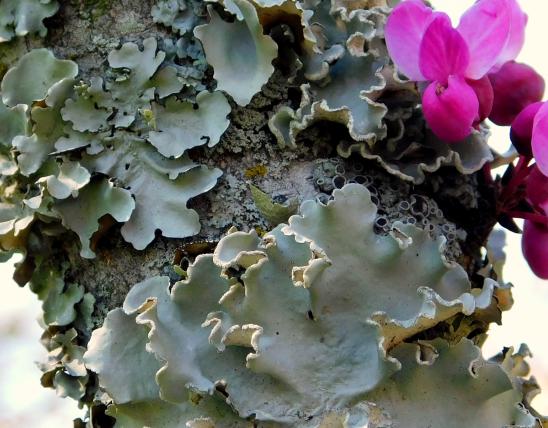
This page is an introduction to mosses as a group. There are hundreds of species of mosses in Missouri.
Mosses are small, low plants that do not have vascular (veinlike) structures for transporting water and nutrients. Also, they do not produce flowers or seeds. Instead, they reproduce by spores that form within a capsule that usually arises at the tip of a slender stalk. Most moss species grow in the form of either cushions or carpets, usually in damp places.
Two Plants In One
Similar to ferns and liverworts, mosses have a two-part life cycle. Understanding how this works will help you identify moss structures and the mosses themselves, so be sure to read Life Cycle below. The green, leafy part we usually think of as a moss "plant" is the gametophyte, the gamete-bearing part of the cycle (it produces gametes: eggs and sperm). In Missouri mosses, the leaves of the gametophyte are not divided or lobed, though some types may have serrated (toothed) margins. The color usually varies from blackish and brownish green to yellow, gold, and whitish green or silvery.
The other part of the life cycle is the sporophyte, technically a separate individual plant, which produces spores. It is the offspring of the gametophyte and grows from the female structures of the gametophyte. It typically has a long, slender stalk (seta) topped with a capsule that produces spores. Some moss sporophytes do not develop stalks, so the capsule forms amid the leaves of the gametophyte. The capsule usually has a well-defined lid called an operculum. The operculum is shed as the capsule matures so that the spores can be released.
When the sporophyte is still very small and hidden in the gametophyte, it is enclosed in a jacket called a calyptra. As the sporophyte develops, the calyptra is pulled from the gametophyte and remains perched on top of the operculum like a little hat.
The sporophytes of mosses usually persist for a long time and are very helpful for identification. See Life Cycle below for more information on moss reproduction.
Cushions and Carpets: Two Major Growth Patterns
With only a few exceptions, Missouri’s mosses are divided into two major categories, based on their growth pattern: cushion mosses (also called acrocarpous or single-stemmed mosses) and carpet mosses (also called pleurocarpous or branching mosses).
- Cushion mosses (acrocarps) usually grow in rounded mounds or tufts. Each stem grows upward from the ground as a single stalk with little or no branching. The spore-bearing structures arise only from the tip of the stem or branch. Examples include pincushion mosses (Leucobryum spp.), juniper haircap moss (Polytrichum juniperinum), and windswept moss (Dicranum scoparium).
- Carpet mosses (pleurocarps) grow horizontally across the substrate, often forming dense, intricate mats of elaborate, freely branching stems. The spore-bearing structures emerge from the sides of the stems, branches, or both (instead of only at the tips). Examples include tree-apron mosses (or tree-skirt mosses, Anomodon spp.), glossy moss (or seductive entodon moss, Entodon seductrix), and fern mosses (Thuidium spp.).
Two More Growth Forms
In addition to our wide variety of cushion and carpet mosses, Missouri has a few other groups with slightly different growth forms: the sphagnum mosses and dendritic (tree) mosses. Their growth habit makes them easy to identify.
- Sphagnum mosses. Missouri has 18 species of sphagnum mosses (peat mosses) (genus Sphagnum). These are large, moisture-loving mosses that branch profusely in a spiral about the upright stems. These branches usually spread and curve back on themselves. The branches occur in groups called fascicles and are frequently most densely clustered and crowded toward the tip of the stem. Overall, they have a shaggy, unkempt appearance. The sporophyte capsules are spherical and black.
- Sphagnum mosses vary in color from whitish green to bright green and are sometimes tinged with purple, pink, red, or brown. The top portion of a sphagnum moss continues to grow even though the lower part dies. The dead lower portion of the plant turns from green to tan to dark brown. Sphagnums are the mosses that form peat. Sphagnums require a very moist, humid habitat. If they are removed from their habitat and dry out, they become very white and enter a period of dormancy.
- Dendritic mosses. Missouri has two species of dendritric mosses (dendroid or tree mosses), both in genus Climacium. They look like dense, lush, rich green mats of tiny trees. The brown, leafless primary stems grow horizontally across the ground. The unbranched secondary stems grow upright from the primary stems to about 2 inches tall. Starting about halfway up the stems, they give rise to many tertiary stems, which are up to about 1 inch long and unbranched. These tertiary stems taper to their tips and are densely covered with clasping green leaves.
Similar Species
Most mosses are so small that many people don’t bother to distinguish them from liverworts, algae, lichens, and very small flowering plants. What is commonly called reindeer moss, for example, is actually a shrubby lichen (a fungus with algae in its tissues). The so-called Spanish moss that lives near the Gulf of Mexico isn’t a moss, either. It’s a narrow-leaved flowering plant in the pineapple (bromeliad) family.
The stems, leaves, and rootlike structures of mosses distinguish them from lichens on land, and in water from the branching filaments of algae, which lack leaflike structures.
Another group of lookalikes are the leafy liverworts, also called scaly liverworts. Few people know about them. These liverworts may resemble tiny, trailing mosses. They have flattened stems with tiny, rounded, overlapping, leaflike scales in 2 apparent rows; the stems often produce side branches. Mosses, meanwhile, typically have leaves whorled all around the stem. Leafy liverwort leaves don’t have midribs, while mosses’ leaves usually have midribs. The leaves of leafy liverworts are often lobed or notched at the tip (use magnification), but while moss leaves may be toothed, they are never lobed or notched. Liverwort reproductive structures are short-lived, while the capsules of mosses may last for weeks or months.
Height: varies with species; our largest mosses may be almost 4 inches tall.
Varies according to species. Although many occur statewide, different species may have certain regional distributions.
Habitat and Conservation
Mosses generally prefer cool, moist, unpolluted areas. They grow on trees, both living and dead. They grow on soil, in streams, and even on the barren, dry rocks of glades and shut-ins. Some 74 species of mosses were identified from glades in southwest Missouri alone. Also, mosses are a dominant form of life in Missouri’s shaded, north- or east-facing, moist cliff natural communities.
Some mosses thrive in human-altered or artificial habitats, including thatched, slate, and shake roofs. They also occur on cement surfaces, especially old concrete in moist, shaded places; disturbed banks along trails and roadways; stacks of firewood; and even lawns, where many people feel mosses are unwelcome compared to turfgrass.
Each species of moss has specific habitat preferences. These habitats vary by temperature, available moisture, and light as well as the texture and chemistry of the substrate. For example, some types of mosses that grow on rocks may be further restricted to either calcareous rock (such as limestone and dolomite) or siliceous rock (such as sandstone and granite).
One of the best times to look for mosses is in early spring, when moisture is plentiful, the air is relatively cool, and sunlight is able to penetrate through the leafless trees to nurture plant life on the ground.
Mosses contain chlorophyll, which enables them to produce their own food, but they do not have true roots or any veinlike tubes to transport water and minerals from the soil to the leaves, where photosynthesis occurs. The leaves are often only one cell thick and absorb water and minerals directly into the chlorophyll-containing cells. This arrangement can leave mosses vulnerable to drying out when there is no moisture available, but most species have developed the ability to tolerate seasonal dry periods to some extent.
Because the sperm of mosses are naked (not enclosed in protective pollen grains), they must swim to the eggs to fertilize them. To swim, they require a thin film of water on the surface of the moss. This is one reason why mosses usually need a damp or wet habitat, or perfectly timed rains, for fertilization to occur.
Status
A checklist of Missouri’s mosses published in 2015 tallied 315 taxa (species and varieties) of mosses in Missouri. Approximately 113 of them are listed as Missouri species of conservation concern, meaning that they are, to some degree, rare or imperiled in Missouri and vulnerable to extirpation from our state.
Life Cycle
Mosses, like ferns, have a two-part life cycle. This way of life is called alternation of generations — a gamete-bearing plant (bearing eggs and sperm) creates offspring that produce spores; the spore-bearing plant creates offspring that produce gametes.
The part we usually think of as the green and leafy, moss "plant" is the gametophyte. The gametophyte produces gametes (eggs and sperm). The gametes are produced in specialized organs at the tips of moss stalks or at certain places along the stems. The gametes unite to form the other part of the life cycle: a sporophyte.
The sporophyte, technically a separate individual plant, grows out of the egg-producing structure of the gametophyte. The sporophyte is the slender stalk tipped with a capsule full of spores.
Mosses also commonly reproduce vegetatively (asexually), from cuttings. A moss plant can be broken and the fragments moved elsewhere, where they can start new patches of moss.
Human Connections
Dried mosses are used as packing materials for fruits and vegetables, fragile items, and live plants.
Horticulturalists often use dried mosses as a top dressing for potted plants.
Certain types of dried mosses are used medicinally by herbalists.
Overgrazing and poor logging practices can disrupt mosses and other ground covers and lead to erosion, altering soil structure and fertility and damaging natural communities, literally from the ground up.
Living moss is used for monitoring heavy metal contamination in streams and rivers. Like lichens, mosses are also used to monitor air pollution.
Mosses have considerable aesthetic and scenic value. Mosses drape around trees and boulders like warm, cozy shawls. They carpet the banks of streams and glisten like emeralds beside seeps and springs. These areas are already beautiful, but mosses make the Missouri landscape even more attractive. This contributes to tourism and to our well-being.
People often cultivate moss as a ground cover. This is especially common in regions where a cool, humid, and cloudy climate makes moss growing easy. Japanese gardeners have raised moss cultivation to an art form. Many people in the Pacific Northwest encourage mosses as a groundcover. But if moss is growing in your lawn, and you don’t want it there, you can reduce the mosses by improving the habitat for grass growth and ensuring healthy grass growth in the fall.
Bonsai artists cultivate jewel-green living mosses at the bases of their tiny trees.
Worldwide, peat moss (Sphagnum spp.), in particular, has had countless uses for humans. Peat forms gradually in bogs as the lower portions of sphagnum mosses die. In regions colder than Missouri, over thousands of years, large deposits of dead sphagnum mosses accumulate to form peat bogs, which have great economic and cultural importance. It has been used by healers; it is used by gardeners; peat deposits are used as a source of fuel in many parts of the world; Scottish distilleries use it to flavor whiskey; and peat bogs have preserved human bodies as natural mummies for thousands of years.
For decades, Missouri State University in Springfield was the base of study for one of North America’s most accomplished bryophytologists, Paul L. Redfearn (1926–2018).
Ecosystem Connections
Several types of animals use mosses as food. In northern tundra regions, where mosses and lichens may dominate the natural communities, mosses are an important food source for many kinds of animals.
Mosses and other small, low plants form a microhabitat where many types of insects and other invertebrates live. Earthworms, centipedes, sowbugs, springtails, snails, and a wide variety of other small animals live in and around mosses. Tartigrades, or water bears, are curious microscopic eight-legged animals that often live among mosses. Shrews, salamanders, frogs, tiny snakes, and other insectivores hunt for a variety of small animals among the mosses.
Many kinds of birds, as well as mice and other mammals, use mosses in nest building. Mosses cushion fragile eggs and delicate, naked young; insulate against cold weather; and camouflage the nest, concealing it from predators. Even bumblebees gather mosses for their nests.
Because many mosses are able to grow on rock or on open ground, they are important in preventing soil erosion and in building soil, allowing larger plants to move into previously uninhabitable areas.
Geological history explains the distribution patterns of many moss species in our state.
- Many mosses found in Missouri, especially in the Ozarks, are also found in southern Appalachia, southern Mexico, and eastern Asia. These species are separated into different areas today because of geological events, such as rising sea levels and glaciations, that eliminated suitable habitat between these areas.
- Some Missouri mosses are holdouts from the last ice age. During the period when glaciers were expanding and retreating, some arctic-boreal plant species expanded their range south to what is now southern Missouri. A few of these northern plants, including several mosses, were able to continue to survive in moist, cool habitats such as the north-facing slopes and bluffs along the Jacks Fork River in Shannon County.
- During dry, warm periods between glaciations, several western species of mosses colonized Missouri and still remain today.
























Mosses, liverworts, hornworts, and lichens seem rather similar, but these organisms are in very different groups. Mosses, liverworts, and hornworts are small, low plants usually found in damp habitats. Unlike more familiar plants, they lack veinlike structures and do not produce flowers or seeds — instead, they produce spores. Meanwhile, lichens are not plants at all: they are a collection of different fungi that have photosynthetic algae living within their tissues.




































